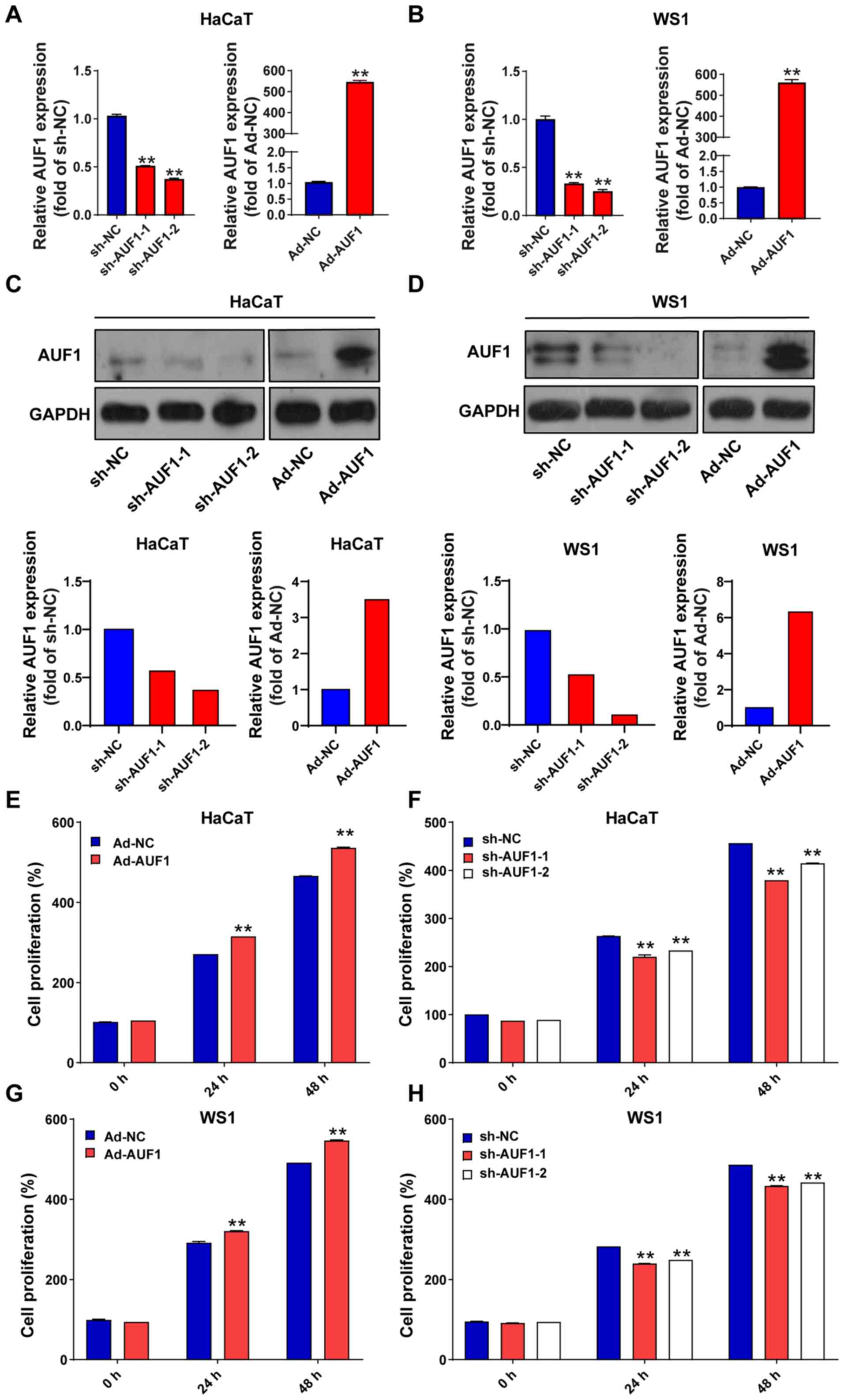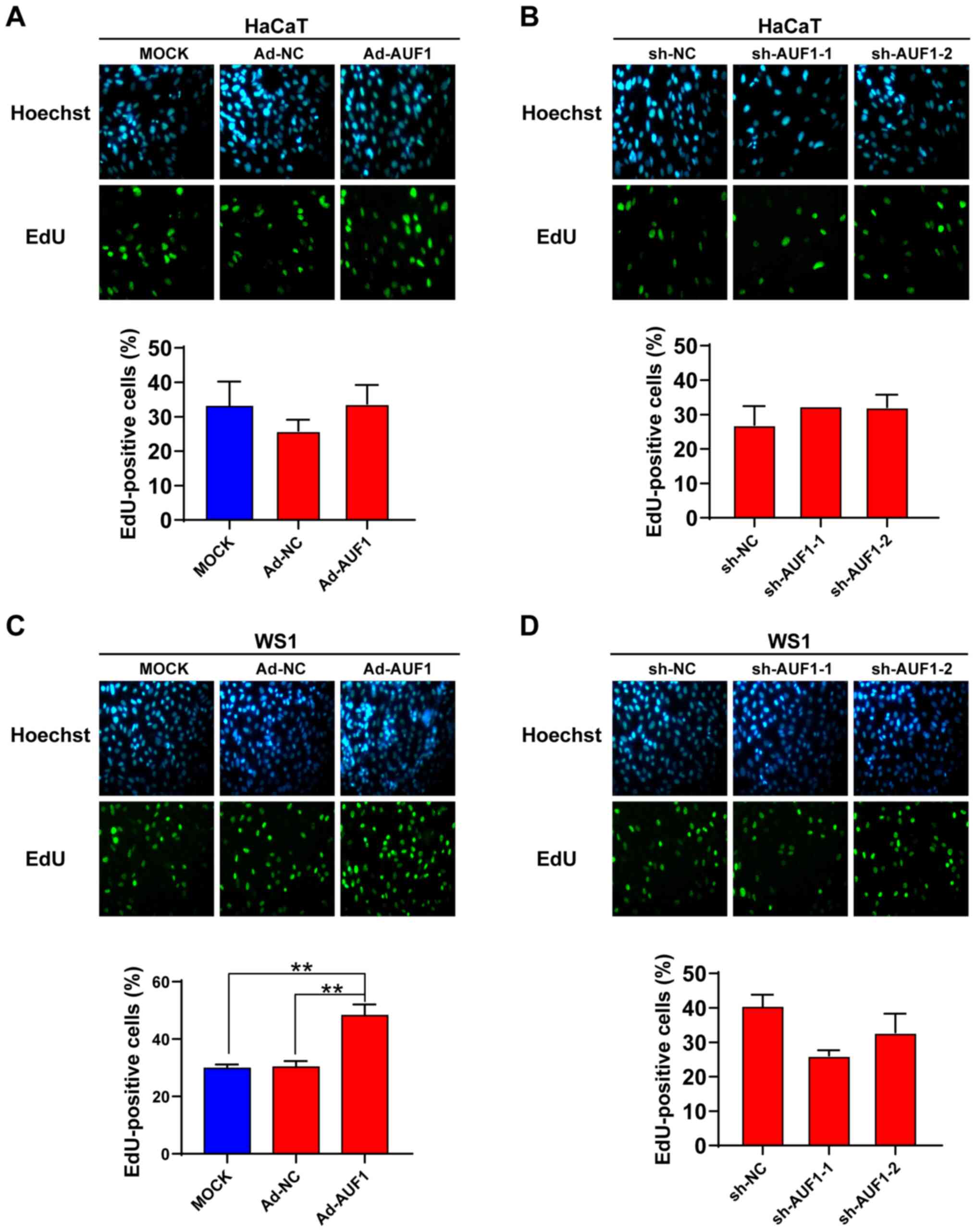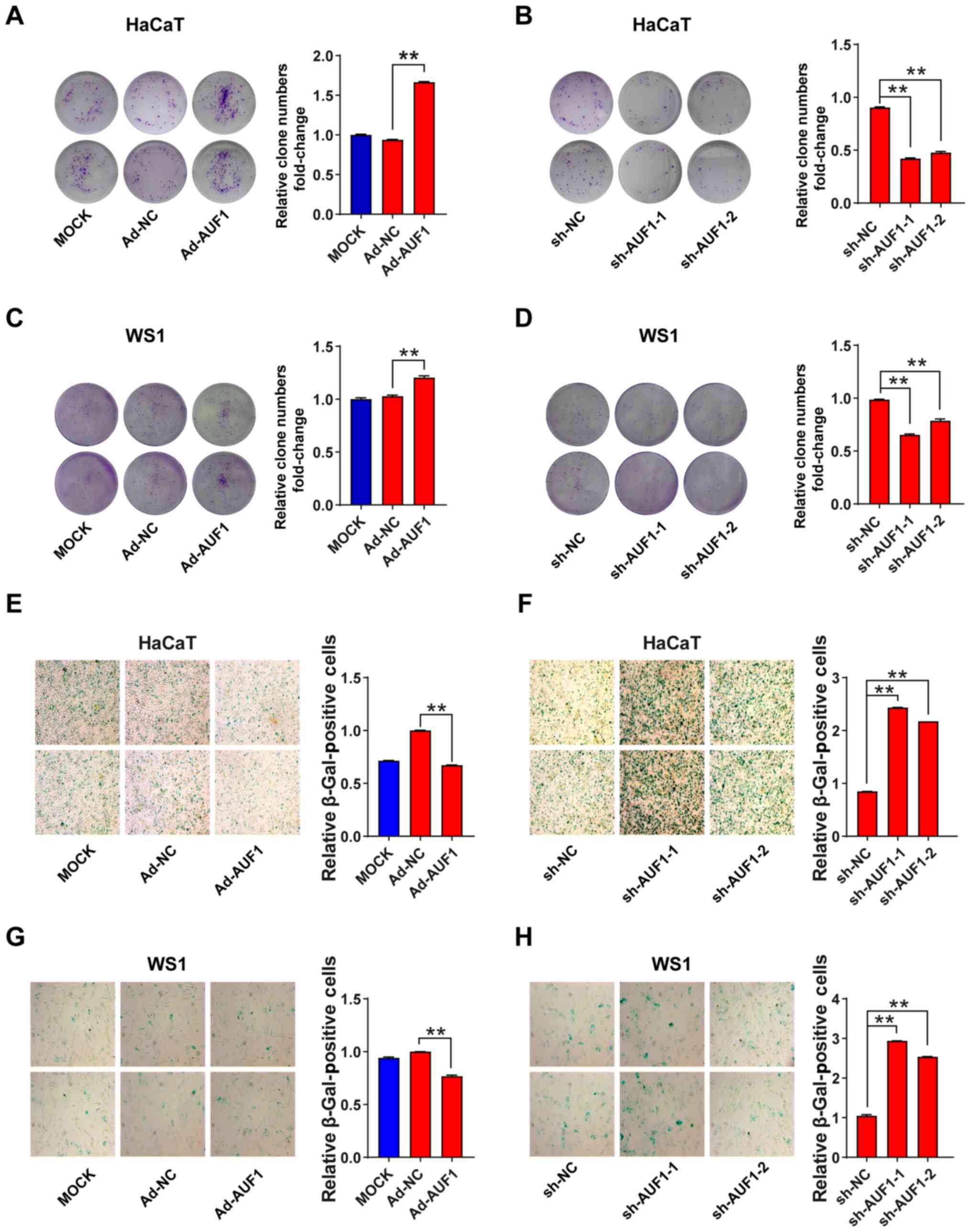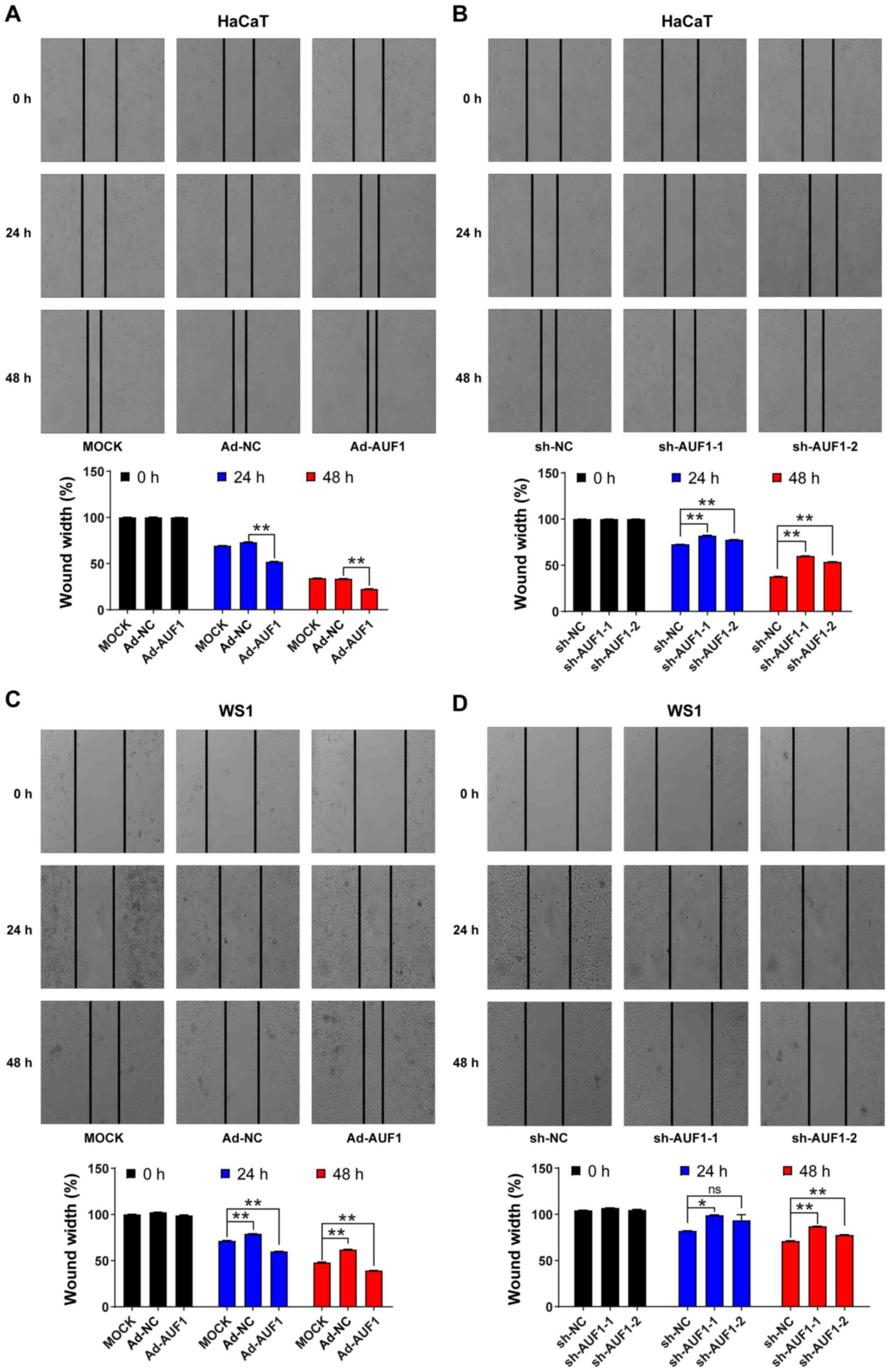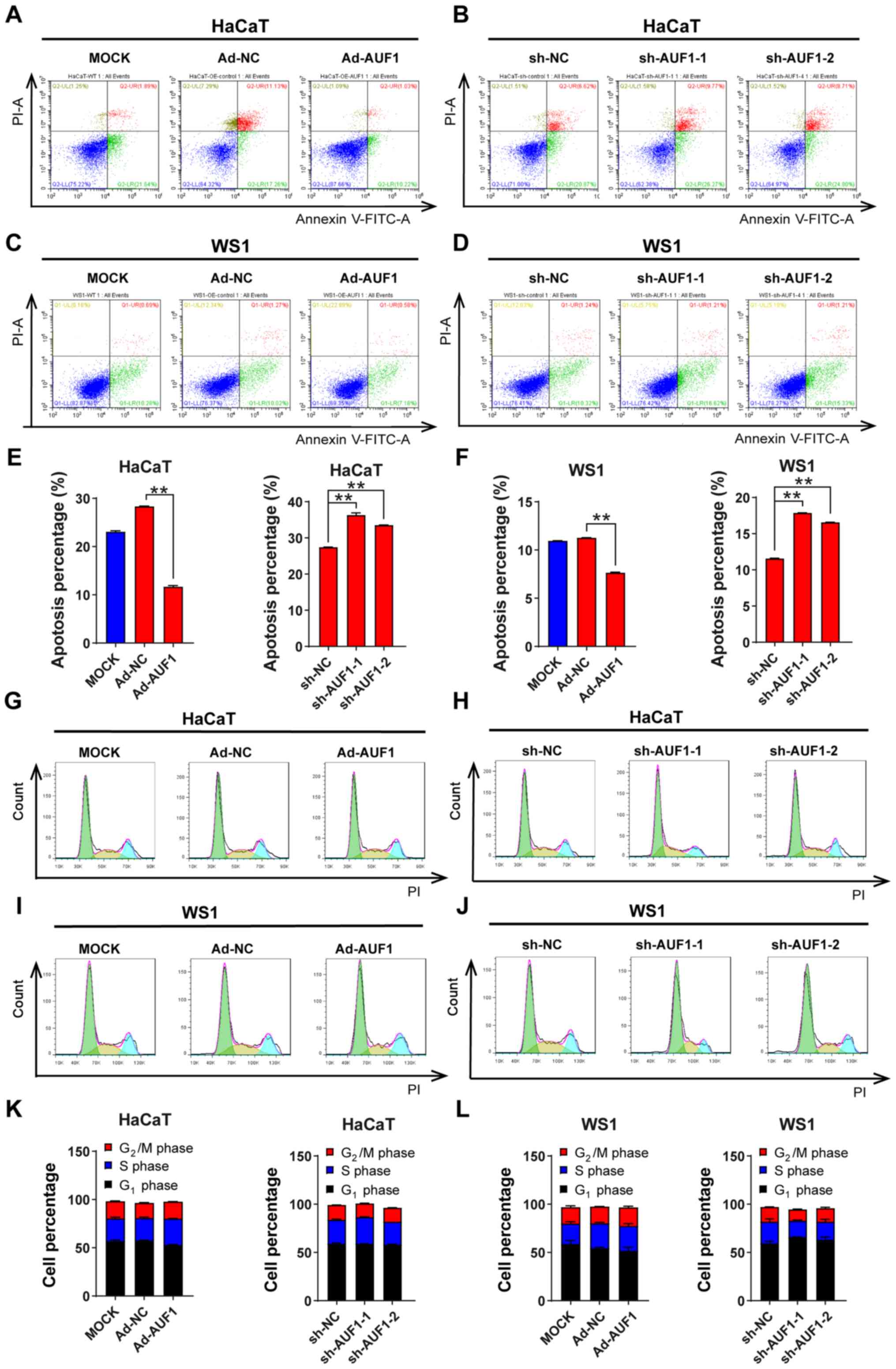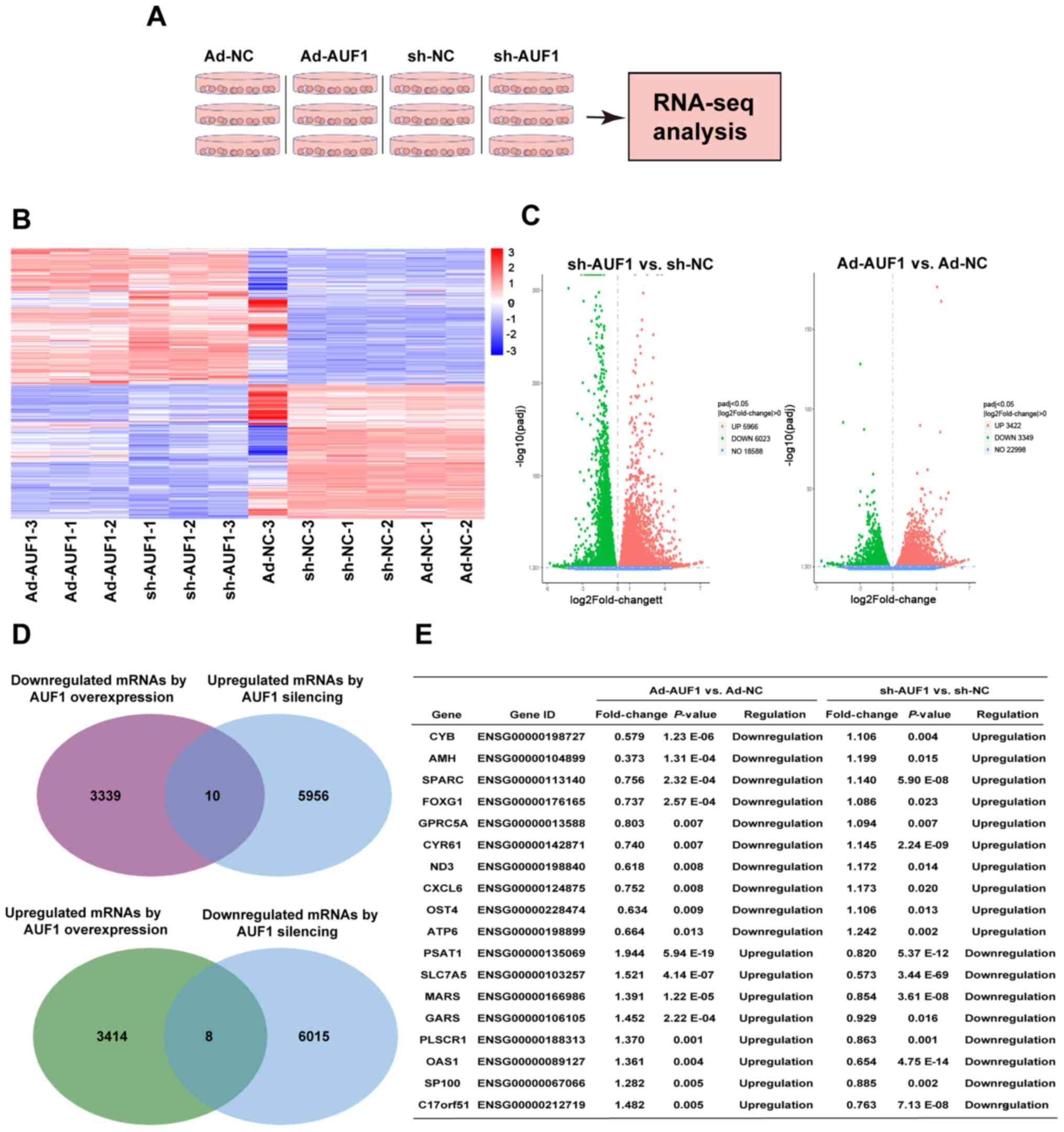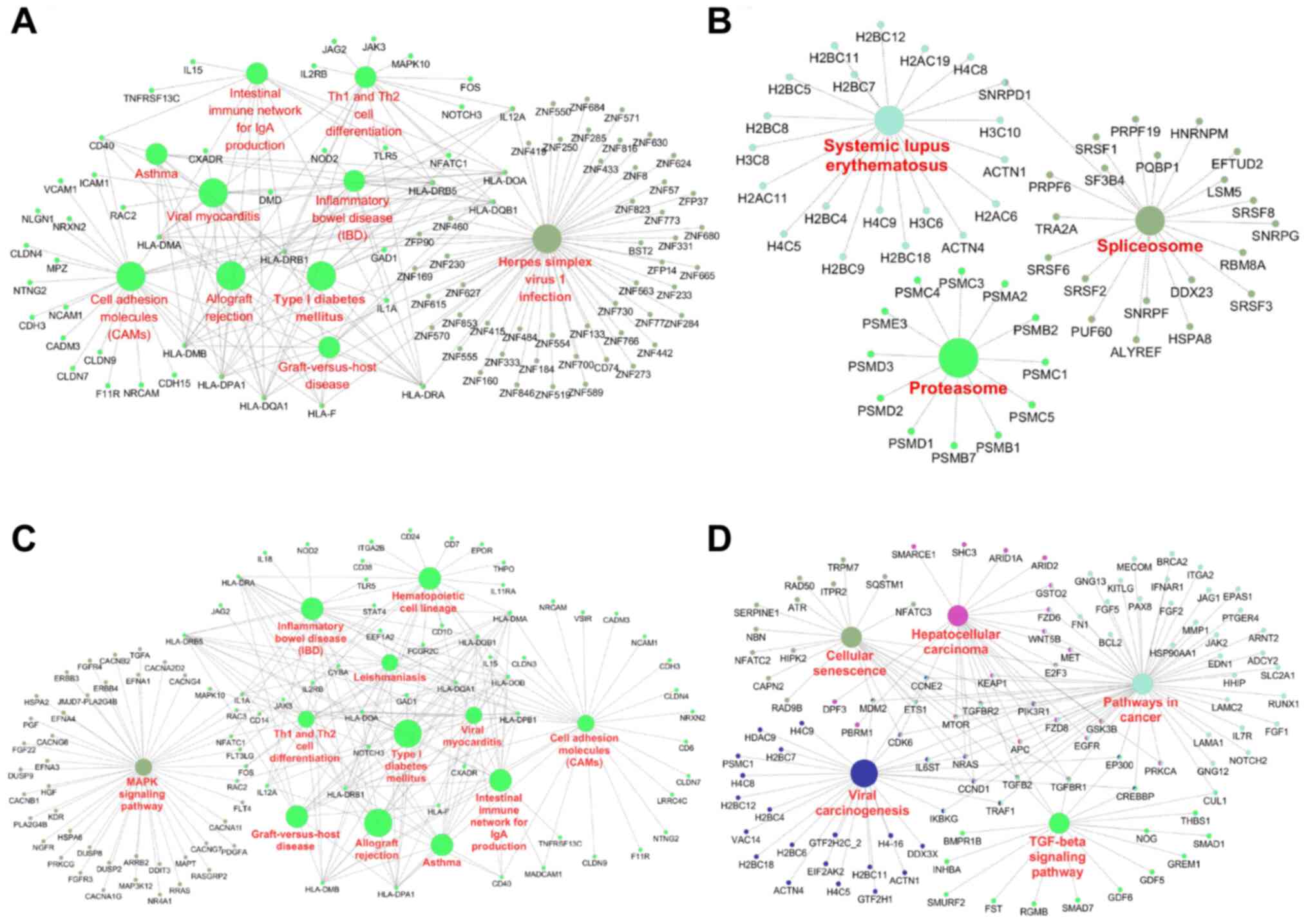|
1
|
Stavast CJ and Erkeland SJ: The
Non-Canonical Aspects of MicroRNAs: Many Roads to Gene Regulation.
Cells. 8(1465)2019.PubMed/NCBI View Article : Google Scholar
|
|
2
|
Loflin P, Chen CY and Shyu AB: Unraveling
a cytoplasmic role for hnRNP D in the in vivo mRNA destabilization
directed by the AU-rich element. Genes Dev. 13:1884–1897.
1999.PubMed/NCBI View Article : Google Scholar
|
|
3
|
Zhang W, Wagner BJ, Ehrenman K, Schaefer
AW, DeMaria CT, Crater D, DeHaven K, Long L and Brewer G:
Purification, characterization, and cDNA cloning of an AU-rich
element RNA-binding protein, AUF1. Mol Cell Biol. 13:7652–7665.
1993.PubMed/NCBI View Article : Google Scholar
|
|
4
|
Wagner BJ, DeMaria CT, Sun Y, Wilson GM
and Brewer G: Structure and genomic organization of the human AUF1
gene: Alternative pre-mRNA splicing generates four protein
isoforms. Genomics. 48:195–202. 1998.PubMed/NCBI View Article : Google Scholar
|
|
5
|
Zucconi BE and Wilson GM: Modulation of
neoplastic gene regulatory pathways by the RNA-binding factor AUF1.
Front Biosci (Landmark Ed). 16:2307–2325. 2011.PubMed/NCBI View
Article : Google Scholar
|
|
6
|
Lozano-Rosas MG, Chávez E, Velasco-Loyden
G, Domínguez-López M, Martínez-Pérez L and Chagoya De Sánchez V:
Diminished S-adenosylmethionine biosynthesis and its metabolism in
a model of hepatocellular carcinoma is recuperated by an adenosine
derivative. Cancer Biol Ther. 21:81–94. 2020.PubMed/NCBI View Article : Google Scholar
|
|
7
|
Gao Y, Wang W, Cao J, Wang F, Geng Y, Cao
J, Xu X, Zhou J, Liu P and Zhang S: Upregulation of AUF1 is
involved in the proliferation of esophageal squamous cell carcinoma
through GCH1. Int J Oncol. 49:2001–2010. 2016.PubMed/NCBI View Article : Google Scholar
|
|
8
|
Sarkar S, Sinsimer KS, Foster RL, Brewer G
and Pestka S: AUF1 isoform-specific regulation of anti-inflammatory
IL10 expression in monocytes. J Interferon Cytokine Res.
28:679–691. 2008.PubMed/NCBI View Article : Google Scholar
|
|
9
|
Trojanowicz B, Sekulla C, Dralle H and
Hoang-Vu C: Expression of ARE-binding proteins AUF1 and HuR in
follicular adenoma and carcinoma of thyroid gland. Neoplasma.
63:371–377. 2016.PubMed/NCBI View Article : Google Scholar
|
|
10
|
Wu X, Yang Y, Huang Y, Chen Y, Wang T, Wu
S, Tong L, Wang Y, Lin L, Hao M, et al: RNA-binding protein AUF1
suppresses miR-122 biogenesis by down-regulating Dicer1 in
hepatocellular carcinoma. Oncotarget. 9:14815–14827.
2018.PubMed/NCBI View Article : Google Scholar
|
|
11
|
He J, Jiang YF, Liang L, Wang DJ, Wei WX,
Ji PP, Huang YC, Song H, Lu XL and Zhao YX: Targeting of AUF1 to
vascular endothelial cells as a novel anti-aging therapy. J Geriatr
Cardiol. 14:515–523. 2017.PubMed/NCBI View Article : Google Scholar
|
|
12
|
Zhang S, Xue J, Zheng J, Wang S, Zhou J,
Jiao Y, Geng Y, Wu J, Hannafon BN and Ding WQ: The superoxide
dismutase 1 3'UTR maintains high expression of the SOD1 gene in
cancer cells: The involvement of the RNA-binding protein AUF-1.
Free Radic Biol Med. 85:33–44. 2015.PubMed/NCBI View Article : Google Scholar
|
|
13
|
Gund R, Zirmire R, J H, Kansagara G and
Jamora C: Histological and Immunohistochemical Examination of Stem
Cell Proliferation and Reepithelialization in the Wounded Skin. Bio
Protoc. 11(e3894)2021.PubMed/NCBI View Article : Google Scholar
|
|
14
|
Sadri N and Schneider RJ:
Auf1/Hnrnpd-deficient mice develop pruritic inflammatory skin
disease. J Invest Dermatol. 129:657–670. 2009.PubMed/NCBI View Article : Google Scholar
|
|
15
|
Livak KJ and Schmittgen TD: Analysis of
relative gene expression data using real-time quantitative PCR and
the 2(-Delta Delta C(T)) method. Methods. 25:402–408.
2001.PubMed/NCBI View Article : Google Scholar
|
|
16
|
Ma W, Qiao J, Zhou J, Gu L and Deng D:
Characterization of novel LncRNA P14AS as a protector of ANRIL
through AUF1 binding in human cells. Mol Cancer.
19(42)2020.PubMed/NCBI View Article : Google Scholar
|
|
17
|
Yan J, Du F, Li SD, Yuan Y, Jiang JY, Li
S, Li XY and Du ZX: AUF1 modulates TGF-β signal in renal tubular
epithelial cells via post-transcriptional regulation of Nedd4L
expression. Biochim Biophys Acta Mol Cell Res. 1865:48–56.
2018.PubMed/NCBI View Article : Google Scholar
|
|
18
|
Al-Khalaf HH and Aboussekhra A: AUF1
positively controls angiogenesis through mRNA
stabilization-dependent up-regulation of HIF-1α and VEGF-A in human
osteosarcoma. Oncotarget. 10:4868–4879. 2019.PubMed/NCBI View Article : Google Scholar
|
|
19
|
Tate S, Imai M, Matsushita N, Nishimura
EK, Higashiyama S and Nanba D: Rotation is the primary motion of
paired human epidermal keratinocytes. J Dermatol Sci. 79:194–202.
2015.PubMed/NCBI View Article : Google Scholar
|
|
20
|
Lu M, Pan C, Zhang L, Ding C, Chen F, Wang
Q, Wang K and Zhang X: ING4 inhibits the translation of
proto-oncogene MYC by interacting with AUF1. FEBS Lett.
587:1597–1604. 2013.PubMed/NCBI View Article : Google Scholar
|
|
21
|
Moore AE, Chenette DM, Larkin LC and
Schneider RJ: Physiological networks and disease functions of
RNA-binding protein AUF1. Wiley Interdiscip Rev RNA. 5:549–564.
2014.PubMed/NCBI View Article : Google Scholar
|
|
22
|
Qian W, Cai X, Qian Q, Wang D and Zhang L:
Angelica sinensis polysaccharide suppresses
epithelial-mesenchymal transition and pulmonary fibrosis via a
DANCR/AUF-1/FOXO3 regulatory axis. Aging Dis. 11:17–30.
2020.PubMed/NCBI View Article : Google Scholar
|
|
23
|
Sun S, Zhang X, Lyu L, Li X, Yao S and
Zhang J: Autotaxin expression is regulated at the
post-transcriptional level by the RNA-binding proteins HuR and
AUF1. J Biol Chem. 291:25823–25836. 2016.PubMed/NCBI View Article : Google Scholar
|
|
24
|
Lee JW, Chun YL, Kim AY, Lloyd LT, Ko S,
Yoon JH and Min KW: Accumulation of mitochondrial RPPH1 RNA
is associated with cellular senescence. Int J Mol Sci Jan.
22(782)2021.PubMed/NCBI View Article : Google Scholar
|
|
25
|
Panda AC, Abdelmohsen K, Yoon JH,
Martindale JL, Yang X, Curtis J, Mercken EM, Chenette DM, Zhang Y,
Schneider RJ, et al: RNA-binding protein AUF1 promotes myogenesis
by regulating MEF2C expression levels. Mol Cell Biol. 34:3106–3119.
2014.PubMed/NCBI View Article : Google Scholar
|
|
26
|
Xu Y, Jiang Y, Wang Y, Ren Y, Zhao Z, Wang
T and Li T: LINC00473 regulated apoptosis, proliferation and
migration but could not reverse cell cycle arrest of human bone
marrow mesenchymal stem cells induced by a high-dosage of
dexamethasone. Stem Cell Res (Amst). 48(101954)2020.PubMed/NCBI View Article : Google Scholar
|
|
27
|
Alimirah F, Pulido T, Valdovinos A,
Alptekin S, Chang E, Jones E, Diaz DA, Flores J, Velarde MC,
Demaria M, et al: Cellular senescence promotes skin carcinogenesis
through p38MAPK and p44/42MAPK signaling. Cancer Res. 80:3606–3619.
2020.PubMed/NCBI View Article : Google Scholar
|
|
28
|
Walczak K, Langner E, Makuch-Kocka A,
Szelest M, Szalast K, Marciniak S and Plech T: Effect of
Tryptophan-Derived AhR Ligands, Kynurenine, Kynurenic Acid and
FICZ, on Proliferation, Cell Cycle Regulation and Cell Death of
Melanoma Cells-In Vitro Studies. Int J Mol Sci.
21(7946)2020.PubMed/NCBI View Article : Google Scholar
|
|
29
|
Lin Q, Jin HJ, Zhang D and Gao L: DDX46
silencing inhibits cell proliferation by activating apoptosis and
autophagy in cutaneous squamous cell carcinoma. Mol Med Rep.
22:4236–4242. 2020.PubMed/NCBI View Article : Google Scholar
|
|
30
|
Liu Q, Dong J, Li J, Duan Y, Wang K, Kong
Q and Zhang H: LINC01255 combined with BMI1 to regulate human
mesenchymal stromal senescence and acute myeloid leukemia cell
proliferation through repressing transcription of MCP-1. Clin
Transl Oncol. 23:1105–1116. 2021.PubMed/NCBI View Article : Google Scholar
|
|
31
|
White EJ, Brewer G and Wilson GM:
Post-transcriptional control of gene expression by AUF1:
Mechanisms, physiological targets, and regulation. Biochim Biophys
Acta. 1829:680–688. 2013.PubMed/NCBI View Article : Google Scholar
|
|
32
|
Yang Y, Wu J, Cai J, He Z, Yuan J, Zhu X,
Li Y, Li M and Guan H: PSAT1 regulates cyclin D1 degradation and
sustains proliferation of non-small cell lung cancer cells. Int J
Cancer. 136:E39–E50. 2015.PubMed/NCBI View Article : Google Scholar
|
|
33
|
Duan W and Liu X: PSAT1 upregulation
contributes to cell growth and cisplatin resistance in cervical
cancer cells via regulating PI3K/AKT signaling pathway. Ann Clin
Lab Sci. 50:512–518. 2020.PubMed/NCBI
|
|
34
|
Lu D, Di S, Zhuo S, Zhou L, Bai R, Ma T,
Zou Z, Chen C, Sun M, Tang J, et al: The long noncoding RNA TINCR
promotes breast cancer cell proliferation and migration by
regulating OAS1. Cell Death Discov. 7(41)2021.PubMed/NCBI View Article : Google Scholar
|
|
35
|
Suh YS, Yeom E, Nam JW, Min KJ, Lee J and
Yu K: Methionyl-tRNA synthetase regulates lifespan in
Drosophila. Mol Cells. 43:304–311. 2020.PubMed/NCBI View Article : Google Scholar
|
|
36
|
Jin Q, Liu G, Wang B, Li S, Ni K, Wang C,
Ren J, Zhang S and Dai Y: High methionyl-tRNA synthetase expression
predicts poor prognosis in patients with breast cancer. J Clin
Pathol. 73:803–812. 2020.PubMed/NCBI View Article : Google Scholar
|
|
37
|
Wu MF, Stachon T, Langenbucher A, Seitz B
and Szentmáry N: Effect of amniotic membrane suspension (AMS) and
amniotic membrane homogenate (AMH) on human corneal epithelial cell
viability, migration and proliferation in vitro. Curr Eye Res.
42:351–357. 2017.PubMed/NCBI View Article : Google Scholar
|
|
38
|
PLOS ONE Editors. Retraction: SPARC
overexpression inhibits cell proliferation in neuroblastoma and is
partly mediated by tumor suppressor protein PTEN and AKT. PLoS One.
15(e0228246)2020.PubMed/NCBI View Article : Google Scholar
|
|
39
|
Zhen J, Zhang H, Dong H and Tong X:
miR-9-3p inhibits glioma cell proliferation and apoptosis by
directly targeting FOXG1. Oncol Lett. 20:2007–2015. 2020.PubMed/NCBI View Article : Google Scholar
|
|
40
|
Cheng Z, Zhang Y, Tian Y, Chen Y, Ding F,
Wu H, Ji Y and Shen M: Cyr61 promotes Schwann cell proliferation
and migration via αvβ3 integrin. BMC Mol Cell Biol.
22(21)2021.PubMed/NCBI View Article : Google Scholar
|
|
41
|
Gui L, Zhu YW, Xu Q, Huang JJ, Hua P, Wu
GJ, Lu J, Ni JB, Tang H and Zhang LL: RNA interference-mediated
downregulation of phospholipid scramblase 1 expression in primary
liver cancer in vitro. Oncol Lett. 20(361)2020.PubMed/NCBI View Article : Google Scholar
|
|
42
|
Held-Feindt J, Hattermann K,
Knerlich-Lukoschus F, Mehdorn HM and Mentlein R: SP100 reduces
malignancy of human glioma cells. Int J Oncol. 38:1023–1030.
2011.PubMed/NCBI View Article : Google Scholar
|
|
43
|
Dang T, Modak C, Meng X, Wu J, Narvaez R
and Chai J: CCN1 induces apoptosis in esophageal adenocarcinoma
through p53-dependent downregulation of survivin. J Cell Biochem.
120:2070–2077. 2018.PubMed/NCBI View Article : Google Scholar
|
|
44
|
Wang R, Li KM, Zhou CH, Xue JL, Ji CN and
Chen JZ: Cdc20 mediates D-box-dependent degradation of Sp100.
Biochem Biophys Res Commun. 415:702–706. 2011.PubMed/NCBI View Article : Google Scholar
|
|
45
|
Verginelli F, Perin A, Dali R, Fung KH, Lo
R, Longatti P, Guiot MC, Del Maestro RF, Rossi S, di Porzio U, et
al: Transcription factors FOXG1 and Groucho/TLE promote
glioblastoma growth. Nat Commun. 4(2956)2013.PubMed/NCBI View Article : Google Scholar
|















